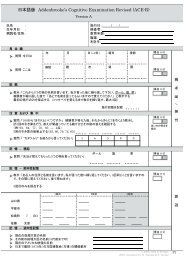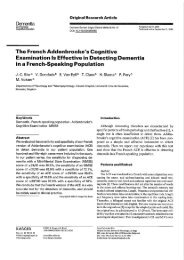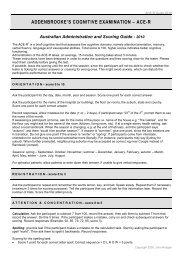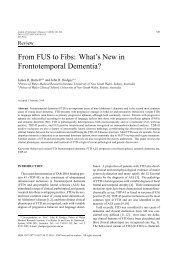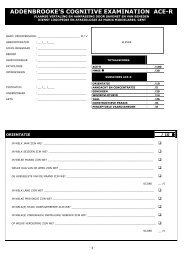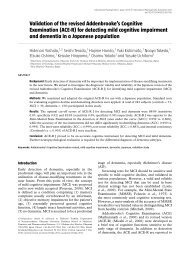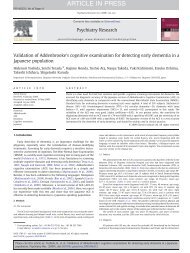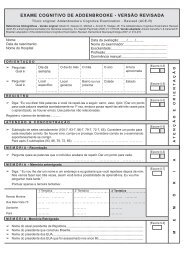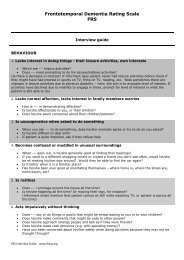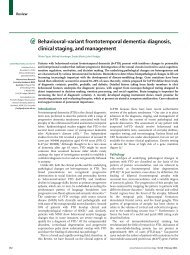Neurocase The Cambridge Semantic Memory Test Battery ...
Neurocase The Cambridge Semantic Memory Test Battery ...
Neurocase The Cambridge Semantic Memory Test Battery ...
You also want an ePaper? Increase the reach of your titles
YUMPU automatically turns print PDFs into web optimized ePapers that Google loves.
Downloaded By: [University of New South Wales] At: 01:21 23 April 2010<br />
patients with so-called MCI also have semantic memory<br />
deficits (e.g., Bennett et al., 2002; Bozoki,<br />
Giordani, Heidebrink, Berent, & Foster, 2001; De<br />
Jager et al., 2003; De Jager & Budge, 2005; Dudas,<br />
Clague, Thompson, Graham, & Hodges, 2005;<br />
Estévez-González et al., 2004; Lambon Ralph et al.,<br />
2003; Thompson, Graham, Patterson, Sahakian, &<br />
Hodges, 2002), when assessed on the updated CSM<br />
test battery.<br />
It is, therefore, timely to determine whether the<br />
updated CSM test battery is sensitive to semantic<br />
deficits in MCI and AD, and to compare directly<br />
the performance of patients with MCI, AD and<br />
SD. This is a valuable goal for a variety of reasons,<br />
including the differentiation of MCI and AD from<br />
other forms of dementia early in the course of the<br />
disease. Such differential diagnoses determine<br />
appropriate information to be given to patients<br />
and their families regarding the nature and likely<br />
time-course of progression, possible genetic implications,<br />
etc; and as effective disease modifying<br />
interventions gradually become available, such<br />
early diagnosis will of course be of even greater<br />
significance.<br />
In addition to the semantic memory measures, a<br />
general neuropsychological battery of tests was<br />
included. <strong>The</strong>se measures include: short-term<br />
memory (digit span), episodic memory (story and<br />
design recall), executive function (letter fluency),<br />
and visuospatial perception. Compatible with a<br />
diagnosis of MCI or AD, previous studies have<br />
revealed episodic memory impairments in patients<br />
with MCI and AD (e.g., Dudas et al., 2005;<br />
Hodges et al., 1990, 1999; Perri, Carlesimo, Serra,<br />
& Caltagirone, 2005; Perry, Watson, & Hodges,<br />
2000; Welsh, Butters, Hughes, Mohs, & Heyman,<br />
1991, 1992), while patients with SD perform well<br />
on at least some measures of non-verbal episodic<br />
recall (e.g., Scahill, Hodges, & Graham, 2005).<br />
Furthermore, patients with AD, but not SD, have<br />
been shown to have deficits on measures of<br />
MCI<br />
(range)<br />
CAMBRIDGE SEMANTIC MEMORY TEST BATTERY 3<br />
attention (e.g., Amieva, Phillips, Della Sala, &<br />
Henry, 2004; Perry & Hodges, 1999; Pignatti<br />
et al., 2005), visuospatial perception (e.g., Caine &<br />
Hodges, 2001; Perry et al., 2000; Ringman, 2005), and<br />
executive function (e.g., Perry & Hodges, 1999), early<br />
in the course of the disease. <strong>The</strong>refore, in addition to<br />
exploring the nature of semantic memory in these<br />
patient groups, this study also aimed to characterise<br />
performance on more general neuropsychological<br />
measures.<br />
In summary, the two main aims of this study<br />
were: (i), to make more fully available the updated<br />
<strong>Cambridge</strong> <strong>Semantic</strong> <strong>Memory</strong> (CSM) test battery,<br />
including a recently devised test intended to be sensitive<br />
to mild semantic impairment (the CCT); and<br />
(ii), to characterise and compare the neuropsychological<br />
profiles of different patient groups (i.e.,<br />
MCI, AD, and SD).<br />
Participants<br />
TABLE 1<br />
<strong>The</strong> mean age at test and years of education<br />
AD<br />
(range)<br />
SD<br />
(range)<br />
METHODS<br />
A total of 75 subjects took part in this study: 7<br />
patients with a clinical diagnosis of amnestic MCI,<br />
8 patients who had a fairly typical AD profile, 15<br />
patients who fitted the criteria for SD, and 45 control<br />
subjects.<br />
Controls were selected from the Medical<br />
Research Council Cognition and Brain Sciences<br />
Unit’s participant panel. Twenty controls were<br />
administered the full semantic battery except for<br />
the Camel and Cactus <strong>Test</strong> (CCT) which was not<br />
yet developed at the time of this original data collection.<br />
An additional 25 controls were subsequently<br />
tested on the CCT.<br />
<strong>The</strong> mean age range and years of education of<br />
the patient groups and the controls are shown in<br />
Table 1. Analysis revealed that the SD group was significantly<br />
younger than the AD group (t(21) = 3.33,<br />
Control<br />
(range)<br />
Control CCTpic<br />
(range)<br />
Control CCTword<br />
(range)<br />
Sex (F/M) 2/5 4/4 5/10 10/10 8/8 10/4<br />
Years of education 10.7 (9–13) 10.1 (9–12) 11.07 (8–13) 11.0 (9–13) 12.7 (10–15) 12.0 (10–14)<br />
Age at test (years) 65.4 (51–78) 72.4 (68–82) 61.4 (42–78) 68.1 (54–78) 63.6 (55–79) 61.0 (55–68)<br />
<strong>The</strong> range is shown for each score. MCI represents mild cognitive impairment; AD represents Alzheimer’s disease; SD represents<br />
semantic dementia; CCT represents Camel and Cactus <strong>Test</strong>.



